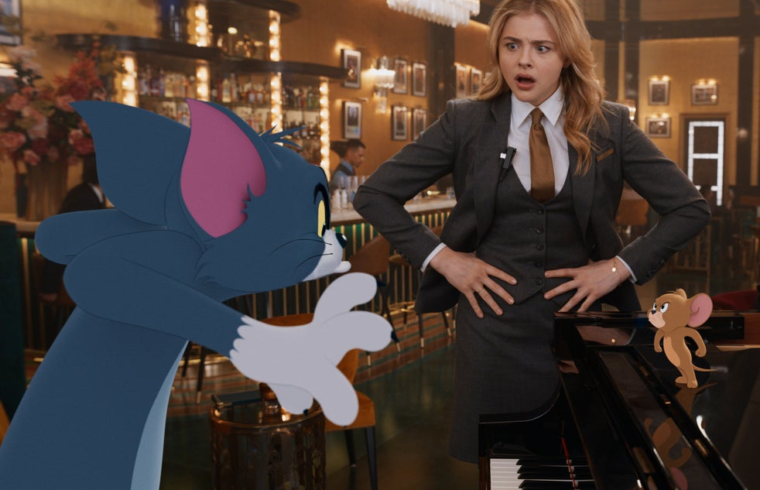Dir: Tim Story. Starring: Chloë Grace Moretz, Michael Peña, Colin Jost, Rob Delaney, Ken Jeong. PG cert, 101 mins
Cat chases mouse. Mouse clubs cat with a mallet. It’s a simple formula, but it works. Tom and Jerry’s cycle of perpetual violence has allowed audiences a consequence-free release for their schadenfreude for 81 years. And yet the pair are somehow not the protagonists of Tom & Jerry The Movie, an interminably odd and unamusing outing that flails wildly, but never in any particular direction. That honour goes to Chloë Grace Moretz’s Kayla – and while the actor does her best to gurn and pose and wring out some kind of joy from the material, she’s been given the unenviable task of making likeable a morally despicable hero.
Kayla is first introduced to us through an act of identity theft, as she steals a woman’s job at New York City’s esteemed Royal Gate Hotel. She spends the rest of the film demanding sympathy from her boss (Rob Delaney, whose resilient chipperness is the best part of the film) and co-workers (Michael Peña and Jordan Bolger). Unsurprisingly, she’s struggling to keep up, especially in the lead-up to the hotel’s biggest event in years – a wedding between socialites Preeta (Pallavi Sharda) and Ben (Colin Jost, who looks lost).
Tom and Jerry, then, are mere accessories to this pedestrian tale of professional fraudulence. Kayla hires Tom to drive Jerry out of the hotel, where he’s taken up residence between the walls, only for the film to dedicate a distressingly small amount of screentime to him doing just that. Instead, screenwriter Kevin Costello has burdened them both with unnecessary backstories: Tom is actually a John Legend wannabe, who’s sent on a John Wick-ian path of vengeance against Jerry when the mouse smashes his electric keyboard. Jerry comes off as, well, a bit of an asshole. The film, directed by Barbershop’s Tim Story, suffers the same way any IP-driven cash-in does – it tries to expand on a basic concept without any care or commitment. It’s the cinematic equivalent of a sausage casing stuffed with mystery meat.
The upside is the decision not to render Tom and Jerry in ghoulish three-dimensions, but for its CGI to have the look of traditional animation. Every animal in this film is a cartoon, even the pigeons who, for some reason, rap A Tribe Called Quest’s classic “Can I Kick It?” at the top of the film. It’s a clear nod to 1988’s Who Framed Roger Rabbit, though the three-decades-old film looks better than this, where it’s obvious that the actors are basically manhandling air.

Chloë Grace Moretz’s Kayla is given the unenviable task of making likeable a morally despicable hero
(Warner Bros)
There’s a complex, and largely inconsistent, logic to the original Tom and Jerry shorts. This version doesn’t go the route of 1992’s equally risible Tom And Jerry: The Movie, where the characters were voiced by Richard Kind and Dana Hill. Cat and mouse are still mute here, communicating through charades and hand gestures. And, true to form, Tom does serenade a lady cat. But by including a whole menagerie of animals – including peacocks, fish, and elephants – there’s a strange new hierarchy at play. Certain species are allowed to talk; others don’t.
None of the humans ever acknowledge this, of course, since they’re all too busy with events management to wonder why the elephants talk to each other in textspeak (“OMG!” “WTF!”). And then there’s the fact that, since all animals are animated, so are the chunks of meat and dead fish in the kitchen. It’s a choice that offers many, many more questions than it does answers. A Tom and Jerry film has to have taken a very wrong turn somewhere to leave its audience wondering about the intricacies of cartoon anatomy.









